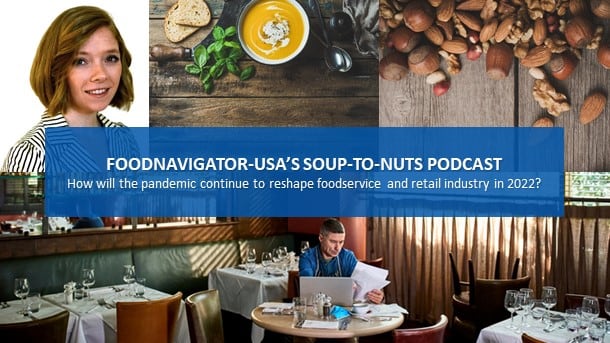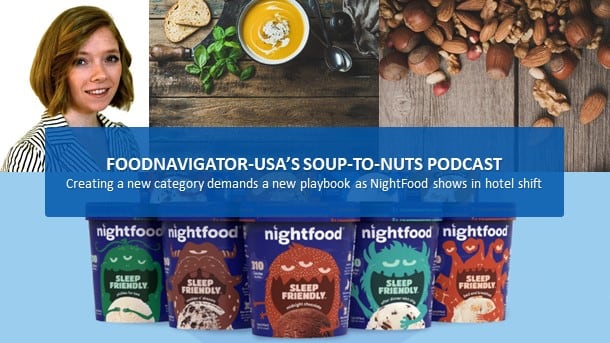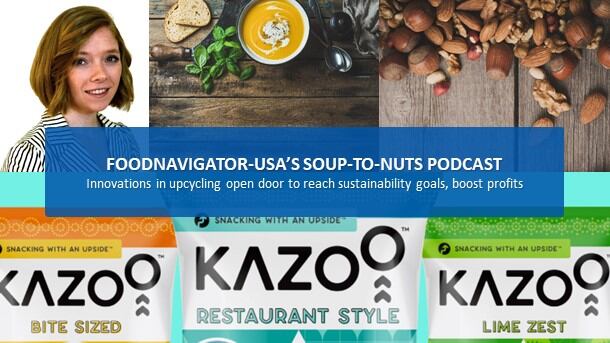Arlin Wasserman, the founder of the food consultancy Changing Tastes, explains that this back-and-forth will hinge at first on consumers’ comfort level and perception of safety, but also longer term on the impact of the quickly evolving economic landscape, a generational shift that sees Millennials more in the driver’s seat and a social awakening about foods’ origins and impact on the planet – all of which are being accelerated by the pandemic.
As he explains in this episode of FoodNavigator-USA’s Soup-To-Nut podcast, each of these factors bring new challenges, like balancing inflation with consumers’ ability to absorb higher costs, recruiting and maintaining top talent to keep businesses running and consumers’ flush with spending money, and creating menus and packaged goods that not only taste good but also meet rising demand for sustainability and historical- and cultural-awareness. But as Wasserman, adds, each of these challenges also bring opportunities that pave the way to a brighter – even if still competitive – future for both food service and retail.
[Editor's note: Never miss another episode of FoodNavigator-USA's Soup To Nuts podcast -- subscribe today.]
The current landscape
As the pandemic enters its third year of unprecedented and often still unpredictable circumstances, Wasserman says competition across the food industry – will heat up, creating a new set of challenges even as those that have defined the pandemic so far cool down.
For example, he notes, consumers are panicking less with each new wave of COVID-19 and other coronavirus variants, which is reshaping their eating habits again so they are more comfortable going to restaurants and eating down the stockpiles of food they have built up in their pantries over the past two years.
He explains that consumers continue to spend on food, but the decision about where to buy and eat it no longer is based on purely on convenience, speed, a desire to be with friends and family, but rather on current pandemic-related regulations, the transmission rate, does a restaurant have enough staff to open or if it is warm enough to eat outside.
“Both grocery retailers and restaurants are now having to get used to waves of consumers picking one channel or the other and switching every day or week. So, my expectation is for a lot of scrambling,” Wasserman said.
At the same time, he believes that consumers will be buying fewer groceries as they eat down the stores that they stocked during the pandemic – finally feeling more confident that food will be on the shelves when they visit and that they will be healthy enough to shop.
“The demand side is going to smooth out some. There are still a few things like toilet paper and bleach and canned foods that do disappear whenever there seems to be some uncertainty about whether we’ll be allowed to go out or get into stores as often as we want, or whether it’s safe to do so, but those things are smoothing out,” he said.
Labor and inflation will continue to challenge industry
Wasserman predicts this in turn will help ease some pent-up pressure on the supply chain due to heightened demand, but, he argues, other contributing factors, like labor challenges, are less likely to subside as quickly. As such, he says, inflation may also linger – and even when it drops, the price increases it drove are unlikely to fall back to pre-pandemic levels.
“The biggest risk I do think is labor cost, and that is because that has really nothing to do with the food industry, per se. We’re seeing that younger generations – Gen Z and some millennials simply are not motivated to go to work, let alone work in the food industry, which can be a demanding job,” he said. “That lack of participation is driving incredible wage inflation.”
Wasserman suggested that the drop in participation has been driven by government policy and subsidies given during the height of the pandemic, and while that money is slowing, some recipients are slower to return to work.
The Great Resignation is complicated though and many factors likely are contributing to a labor challenges. For example, women have left the workforce in droves, not because they wanted to or didn’t need the money, but because childcare and school have been unreliable throughout the pandemic and these tasks still fall disproportionately to them in the US. Others have left jobs where they felt unappreciated, in danger or under paid in favor of employment elsewhere as reflected in both the quit rates and new hire rates published by the government.
Many workers also do not feel their pay is commiserate with these new dangers and challenges and are demanding higher wages, which Wasserman says could contribute to more inflation if unchecked.
But the idea of keeping wages “low enough to prevent more inflation” may be divisive for some industry players – including those stocking shelves and delivering meals, who increasingly are forming unions and taking to picket lines to command better labor conditions, including higher wages, better health benefits and improved safety standards. The involvement of President Joe Biden and Sen. Bernie Sanders in two recent high profile strikes at Kellogg’s and Kroger respectively, also signal there are political heavyweights and significant public opinion to back up labors demands.
While higher wages and better benefits could go a long ways to make the food industry more attractive for employees, Wasserman also notes industry recruiters may have better luck attracting talent and loyal employees if they better highlight the longer-term career paths and skills training that industry historically has offered.
The food industry is an amazingly great one for creating jobs and careers, especially for people who may be at economic disadvantage, maybe new immigrants or recent immigrants, um, may be at, uh, educational disadvantage, uh, as they, you know, wrestle with either structural racism, economic disparity, learning a new language. Why? Because the food industry is one where you don't need a lot of formal education or training to enter it. And you learn most of what you need while you're working in the industry and can build a great career, whether that's working your way up from a dishwasher to a restaurant manager or a chef or a district manager for a food service company, or working your way up from the produce department to being a purchasing manager,” he said.
Winners will focus on climate change, cultural influence
In addition to accelerating a labor rights movement in the food industry, the pandemic also is shining a light on the cultural significance and environmental impact of food, which Wasserman says is fueling dramatic shifts in how menus, CPG brands and individual ingredients are represented and selected.
“We do talk about menus getting ‘woke’ in the year ahead. Prior to COVID, we had the me too movement in the restaurant industry … and American has become woke to structural racism in our country. The food industry may get there soon,” and it will play out by acknowledging where key ingredients, recipes and dishes originated, he said.
“Most of our food that we think of as American was really brought here by waves of immigration, including enslaved people who came here against their will, and I think this is a chance to recognize that our diversity has made our menus and our pantries and our supermarket shelves much more interesting,” he said.
The food industry also has a unique opportunity to change the narrative around its environmental impact, according to Wasserman, who says by carefully selecting ingredients and dishes that are not just sustainable but also regenerative restaurants can help create consumer demand that will change the products brands bring to market and retailers’ stock.
Changing paths to market
As these trends emerge and merge in the coming years, and as food service rebuild their competitive status, Wasserman predicts the traditional path to market for CPG products and retail innovations also will evolve to more closely resemble restaurant offerings.
“More Americans, especially young Americans, don’t like to cook. They don’t like to cook fish, but they also don’t like to cook a lot of other stuff, too. So culinary innovation is going to become more important to grocery retail than ever before” with offerings being closer to the plated meals purchased at restaurants, he said.
He also noted that the traditional path of introducing new flavors or foods to consumers first through food service and then at retail once they are familiar with how to prepare the products, will be less available as restaurants have become less reliable.
As such he argues that product innovators will need to teach products and new ways of eating via social media, and offer the products in a format that is much closer to ready to eat than before.
While the full impact of the pandemic on the food industry has yet to be seen, Wasserman says he is confident in the industry’s ability not only to meet the higher bar consumers are setting, but continue to raise it the coming years for the benefit of all.




